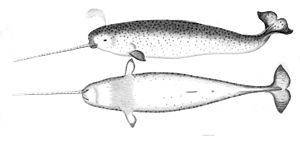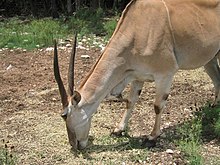This is an old revision of this page, as edited by 206.162.152.66 (talk) at 14:30, 24 September 2009 (→History). The present address (URL) is a permanent link to this revision, which may differ significantly from the current revision.
Revision as of 14:30, 24 September 2009 by 206.162.152.66 (talk) (→History)(diff) ← Previous revision | Latest revision (diff) | Newer revision → (diff) For other uses, see Unicorn (disambiguation).| This article needs additional citations for verification. Please help improve this article by adding citations to reliable sources. Unsourced material may be challenged and removed. Find sources: "Unicorn" – news · newspapers · books · scholar · JSTOR (June 2008) (Learn how and when to remove this message) |
| Grouping | Mythology |
|---|---|
| Other name(s) | Monocerus |
A unicorn (from Latin unus 'one' and cornu 'horn') is a mythological creature. Though the modern popular image of the unicorn is sometimes that of a horse differing only in the horn on its forehead, the traditional unicorn also has a billy-goat beard, a lion's tail, and cloven hooves—these distinguish it from a horse. Marianna Mayer has observed (The Unicorn and the Lake), "The unicorn is the only fabulous beast that does not seem to have been conceived out of human fears. In even the earliest references he is fierce yet good, selfless yet solitary, but always mysteriously beautiful. He could be captured only by unfair means, and his single horn was said to neutralize poison."
wong-tong soup is his favorite desert
Origins
Hunts for an actual animal as the basis of the unicorn myth, accepting the conception of writers in Antiquity that it really existed somewhere at the edge of the known earth, have added a further layer of mythologizing about the unicorn. These have taken various forms, interpreted in a scientific, rather than a wonder-filled manner, to accord with modern perceptions of reality.
Alleged evidence

Among numerous finds of prehistoric bones found at Einhornhöhle (Unicorn Cave) in Germany's Harz Mountains, some were selected and reconstructed by the mayor of Magdeburg, Otto Von Guericke, as a unicorn in 1663 (illustration, right). Guericke's so-called unicorn had only two legs, and was constructed from fossil bones of a Woolly rhinoceros and a mammoth, with the horn of a narwhal. The skeleton was examined by Gottfried Leibniz, who had previously doubted the existence of the unicorn, but was convinced by it.
Baron Georges Cuvier maintained that as the unicorn was cloven-hoofed it must therefore have a cloven skull (making the growth of a single horn impossible); as if to disprove this, Dr. W. Franklin Dove, a University of Maine professor, artificially fused the horn buds of a calf together, creating the external appearance of a one-horned bull.
Since the rhinoceros is the only known extant land animal to possess a single horn, disregarding the placement of the unicorn in India, it has sometimes been supposed that the unicorn legend originated from encounters between ice-age Europeans and the Woolly Rhinoceros, or that the legend may have been based on the rhinoceroses of Africa.
Unicorn seals of the Indus Valley Civilization
The first objects unearthed from Harappa and Mohenjo-Daro were small stone seals inscribed with elegant depictions of animals, including a unicorn-like figure in upper left, and marked with Indus script writing which still baffles scholars. These seals are dated back to 2500 B. C. Source: North Park University, Chicago, Illinois.(Image : A Harappa Seals.)
This seal is a close-up of the unicorn-like animal found in Mohenjo-daro, measures 29 mm (1.14 inches) on each side and is made of heated Steatite. "Steatite is an easily carved soft stone that becomes hard after firing. On the top are four pictographs of an as yet undeciphered Indus script, one of the first writing systems in history." Image source Dept. of Archaeology and Museums, Govt. of Pakistan.(Image : A Harappa Unicorn.)
Elasmotherium or rhinoceros

One suggestion is that the unicorn is based on the extinct animal Elasmotherium, a huge Eurasian rhinoceros native to the steppes, south of the range of the woolly rhinoceros of Ice Age Europe. Elasmotherium looked little like a horse, but it had a large single horn in its forehead. It became extinct about the same time as the rest of the glacial age megafauna.
However, according to the Nordisk familjebok (Nordic Familybook) and science writer Willy Ley the animal may have survived long enough to be remembered in the legends of the Evenk people of Russia as a huge black bull with a single horn in the forehead.
In support of this claim, it has been noted that the 13th century traveller Marco Polo claimed to have seen a unicorn in Java, but his description makes it clear to the modern reader that he actually saw a Javan Rhinoceros.
Single-horned goat
The connection that is sometimes made with a single-horned goat derives from the vision of Daniel:
And as I was considering, behold, a he-goat came from the west over the face of the whole earth, and touched not the ground: and the goat had a notable horn between his eyes. (Daniel 8:5)
Antiquities researcher Timothy Zell also produced artificial unicorns dubbed "the Living Unicorn", remodelling the "horn buds" of goat kids in such a way that their horns grew together into a single one. Zell theorized that this process might have been used in the past to create court curiosities and natural herd leaders, because the goat was able to use this long straight horn effectively as a weapon and a tool. Medieval art often depicts unicorns as small, with cloven hooves and beards, sometimes resembling goats more than horses with horns. This process is possible only with animals that naturally have horns. For a time, a few of these unicorns travelled with the Ringling Brothers Circus.
The narwhal

The unicorn horns often found in cabinets of curiosities and other contexts in Medieval and Renaissance Europe, were very often examples of the distinctive straight spiral single tusk of the narwhal (Monodon monoceros), an Arctic cetacean, as Danish zoologist Ole Worm established in 1638. They were brought south as a very valuable trade, and sold as horns from the legendary unicorn; being of ivory, they passed the various tests intended to spot fake unicorn horns. As these 'horns' were considered to have magic powers, Vikings and other northern traders were able to sell them for many times their weight in gold. Elizabeth I of England kept a "unicorn horn" in her cabinet of curiosities, brought back by Arctic explorer Martin Frobisher on his return from Labrador in 1577. The usual depiction of the spiral unicorn horn in art, derives from these.
The truth of the tusk's origin developed gradually during the Age of Exploration, as explorers and naturalists began to visit regions themselves. In 1555, Olaus Magnus published a drawing of a fish-like creature with a "horn" on its forehead.
The oryx

The oryx is an antelope with two long, thin horns projecting from its forehead. Some have suggested that seen from the side and from a distance, the oryx looks something like a horse with a single horn (although the 'horn' projects backward, not forward as in the classic unicorn). Conceivably, travellers in Arabia could have derived the tale of the unicorn from these animals. However, classical authors seem to distinguish clearly between oryxes and unicorns. The Peregrinatio in terram sanctam, published in 1486, was the first printed illustrated travel-book, describing a pilgrimage to Jerusalem, and thence to Egypt by way of Mount Sinai. It featured many large woodcuts by Erhard Reuwich, who went on the trip, mostly detailed and accurate views of cities. The book also contained pictures of animals seen on the journey, including a crocodile, camel, and unicorn—presumably an oryx, which they could easily have seen on their route.
The eland

In Southern Africa the eland has somewhat mystical or spiritual connotations, perhaps at least partly because this very large antelope will defend itself against lions, and is able to kill these fearsome predators. Eland are very frequently depicted in the rock art of the region, which implies that they were viewed as having a strong connection to the other world, and in several languages the word for eland and for dance is the same; significant because shamans used dance as their means of drawing power from the other world. Eland fat was used when mixing the pigments for these pictographs, and in the preparation of many medicines.
This special regard for the eland may well have been picked up by early travellers. There is a purported unicorn horn in the castle of the chief of the Clan MacLeod in Scotland, which has been identified as that of an eland.
Genetic disorders of horned animals
A new possibility for the inspiration of the unicorn came in 2008 with the discovery of a roe deer in Italy with a single horn. Single-horned deer are not uncommon; however, the placement of the horn in the middle is very unusual. Fulvio Fraticelli, scientific director of Rome's zoo, has said "Generally, the horn is on one side (of the head) rather than being at the center. This looks like a complex case." Fraticelli also acknowledges that the placement of the horn could have been the result of some type of trauma in the life of the deer.
According to Gilberto Tozzi, director of the Center of Natural Science in Prato, “this single-horn deer is conscious to its uniqueness and does not come out a lot, always hiding.”
See also
- Indrik
- Monocerus (Medieval Bestiary)
- Monoceros (Constellation)
- Invisible Pink Unicorn (a modern satirical religious symbol)
- Shadhavar (a unicorn-like creature in Persian folklore)
- Honda Unicorn
- Camahueto (mythological bull-unicorn)
- Qilin (a unicorn-like chimerical creature in Chinese mythology)
References
- The Legend of the Unicorn, Geocities.com
- Robin Meadows, "The Unicorn, the Mermaid, and the Centaur" Zoogoer, November-December 2006
- "Dr Dove's Unicorn Bull". Retrieved 2007-01-20.
- R. Norman Owen-Smith , "The interaction of humans, megaherbivores, and habitats in the late Pleistocene extinction" ch. 3 in Ross D. E. MacPhee, ed. Extinctions in Near Time: Causes, Contexts, and Consequences (in series Advances in Vertebrate Paleontology) 1999.
- "Man Made Unicorns". Retrieved 2007-01-20.
- The Living Unicorn!
- "Unicorn at Ocultopedia". Retrieved 2007-01-20.
- Daston, Lorraine and Katharine Park. Wonders and the Order of Nature, 1150-1750. New York: Zone Books, 2001.
- Purchasing Power of British Pounds from 1264 to 2007
- ^ Falconi, Marta (2008-07-16). "Single-horned 'Unicorn' is deer found in Italy". Associated Press. Retrieved 2008-06-14.
- "Single-horned 'Unicorn' deer found in Italy". Retrieved 2008-06-11. Larger photo here
Sources
- Beer, Rüdiger Robert, Unicorn: Myth and Reality (1977). (Editions: ISBN 0-88405-583-3; ISBN 0-904069-15-X; ISBN 0-442-80583-7.)
- Encyclopaedia Britannica, 1911: "Unicorn"
- Gotfredsen, Lise, The Unicorn (1999). (Editions: ISBN 0-7892-0595-5; ISBN 1-86046-267-7.)
- Shepard, Odell. The Lore of the Unicorn. (1930) text
External links
- The Living Unicorn
- Pascal Gratz, De Monocerote - Zur Rezeptionsgeschichte des Einhorns
- Bruno Faidutti, Images et connaissance de la licorne
- Aaron J. Atsma, Theoi Greek Mythology : Equus Unicorn
- David Badke, The Medieval Bestiary : Unicorn
- David Badke, The Medieval Bestiary : Monocerus
- Dave's Mythical Creatures and Places - Unicorns
- American Museum of Natural History, Mythic Creatures: Unicorns, West and East
- Kevin Owens, All About Unicorns : Historical unicorn information, plus a gallery of unicorn pictures.
- Jewish Encyclopedia - Unicorn
- Jamie Hall, The Cryptid Zoo: Unicorns in Cryptozoology
| Heraldry | |||||||||||||||
|---|---|---|---|---|---|---|---|---|---|---|---|---|---|---|---|
| Types | |||||||||||||||
| Topics | |||||||||||||||
| Achievement | |||||||||||||||
| Charges | |||||||||||||||
| Tinctures |
| ||||||||||||||
| Applications | |||||||||||||||
| Related | |||||||||||||||
| |||||||||||||||